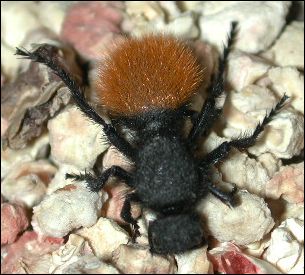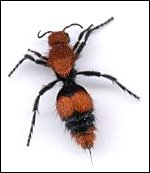
Wandering across the desert, you might notice something small, bright red, velvety, and very quick. You've encountered one of nature's enchantresses—a velvet ant. Despite the name, you are really not looking at an ant at all—this little lady is really a wasp, and she can give a nasty sting! So powerful, in fact, that in some places she's called cow killer.
How do we know it's a female? Simple, really—the males have wings, so they don't look so ant-like. They're also a lot tougher to spot, so if you see one, you should feel privileged. The males swoop down and carry off females who have climbed to the top of grass stalks to spread their enticing scent to potential mates. Eventually, the females lay their eggs in the sand, and the cycle of life starts once more.
Indeed, this marvel of nature is magnificent to behold, but if
you're wise, you'll resist the urge to touch this velvety creature. You may
learn the hard way that roses aren't the only beauties that have
"thorns"! 
Contributor: Kodi R. Jeffery, Centennial Museum, University of Texas at El Paso.
Desert Diary is a joint production of the Centennial Museum and KTEP National Public Radio at the University of Texas at El Paso.


A large female, velvet ant in captivity. There are a number of different species, another of which is shown on the right. Photograph and specimen scan by A.H. Harris.
Schmidt, J. O. 2000. Wasps. Pp. 345-348, in A natural history of the Sonoran Desert. Arizona-Sonora Desert Museum, Tucson, 628 pp.
University of Nebraska--Lincoln.